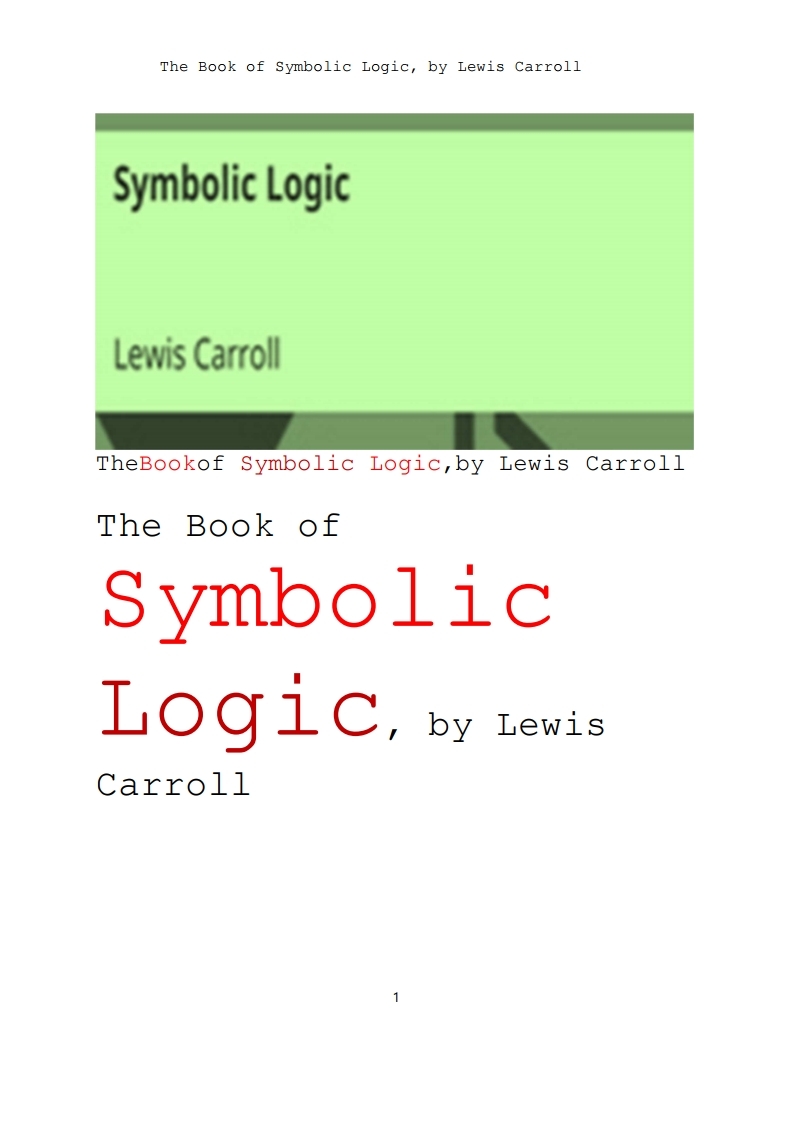기호 논리학.Symbolic Logic, by Lewis Carroll
CONTENTS
BOOK I.
THINGS AND THEIR ATTRIBUTES.
CHAPTER I.
INTRODUCTORY.
PAGE
‘Things’ 1
‘Attributes’ 〃
‘Adjuncts’ 〃
CHAPTER II.
CLASSIFICATION.
‘Classification’ 1½
‘Class’ 〃
‘Peculiar’ Attributes 〃
‘Genus’ 〃
‘Species’ 〃
‘Differentia’ 〃
‘Real’ and ‘Unreal’, or ‘Imaginary’, Classes 2
‘Individual’ 〃
A Class regarded as a single Thing 2½
pg_xvi
CHAPTER III.
DIVISION.
§ 1.
Introductory.
‘Division’ 3
‘Codivisional’ Classes 〃
§ 2.
Dichotomy.
‘Dichotomy’ 3½
Arbitrary limits of Classes 〃
Subdivision of Classes 4
CHAPTER IV.
NAMES.
‘Name’ 4½
‘Real’ and ‘Unreal’ Names 〃
Three ways of expressing a Name 〃
Two senses in which a plural Name may be used 5
CHAPTER V.
DEFINITIONS.
‘Definition’ 6
Examples worked as models 〃
pg_xvii
BOOK II.
PROPOSITIONS.
CHAPTER I.
PROPOSITIONS GENERALLY.
§ 1.
Introductory.
Technical meaning of “ some” 8
‘Proposition’ 〃
‘Normal form’ of a Proposition 〃
‘Subject’, ‘Predicate’, and ‘Terms’ 9
§ 2.
Normal form of a Proposition.
Its four parts:―
(1) ‘Sign of Quantity’ 〃
(2) Name of Subject 〃
(3) ‘Copula’ 〃
(4) Name of Predicate 〃
§ 3.
Various kinds of Propositions.
Three kinds of Propositions:―
(1) Begins with “ Some” . Called a ‘Particular’ Proposition: also a
Proposition ‘in I’ 10
(2) Begins with “ No” . Called a ‘Universal Negative’ Proposition: also
a Proposition ‘in E’ 〃
(3) Begins with “ All” . Called a ‘Universal Affirmative’ Proposition:
also a Proposition ‘in A’ 〃
pg_xviii
A Proposition, whose Subject is an Individual, is to be regarded as
Universal 〃
Two kinds of Propositions, ‘Propositions of Existence’, and ‘Propositions
of Relation’ 〃
CHAPTER II.
PROPOSITIONS OF EXISTENCE.
‘Proposition of Existence ’ 11
CHAPTER III.
PROPOSITIONS OF RELATION.
§ 1.
Introductory.
‘Proposition of Relation’ 12
‘Universe of Discourse,’ or ‘Univ.’ 〃
§ 2.
Reduction of a Proposition of Relation to Normal form.
Rules 13
Examples worked 〃
§ 3.
A Proposition of Relation, beginning with “All”, is a Double Proposition.
Its equivalence to two Propositions 17
pg_xix
§ 4.
What is implied, in a Proposition of Relation, as to the Reality of its
Terms?
Propositions beginning with “ Some” 19
Propositions beginning with “ No” 〃
Propositions beginning with “ All” 〃
§ 5.
Translation of a Proposition of Relation into one or more Propositions of
Existence.
Rules 20
Examples worked 〃
BOOK III.
THE BILITERAL DIAGRAM.
CHAPTER I.
SYMBOLS AND CELLS.
The Diagram assigned to a certain Set of Things, viz. our Univ. 22
Univ. divided into ‘the x- Class’ and ‘the x
′- Class’ 23
The North and South Halves assigned to these two Classes 〃
The x- Class subdivided into ‘the xy- Class’ and ‘the xy
′- Class’ 〃
The North- West and North- East Cells assigned to these two Classes 〃
The x
′- Class similarly divided 〃
The South- West and South- East Cells similarly assigned 〃
The West and East Halves have thus been assigned to ‘the y- Class’ and
‘the y
′- Class’ 〃
Table I. Attributes of Classes, and Compartments, or Cells, assigned to
them 25
pg_xx
CHAPTER II.
COUNTERS.
Meaning of a Red Counter placed in a Cell 26
Meaning of a Red Counter placed on a Partition 〃
American phrase “ sitting on the fence” 〃
Meaning of a Grey Counter placed in a Cell 〃
CHAPTER III.
REPRESENTATION OF PROPOSITIONS.
§ 1.
Introductory.
The word “ Things” to be henceforwards omitted 27
‘Uniliteral’ Proposition 〃
‘Biliteral’ do. 〃
Proposition ‘in terms of’ certain Letters 〃
§ 2.
Representation of Propositions of Existence.
The Proposition “ Some x exist” 28
Three other similar Propositions 〃
The Proposition
도서소개
저자소개
목차소개





